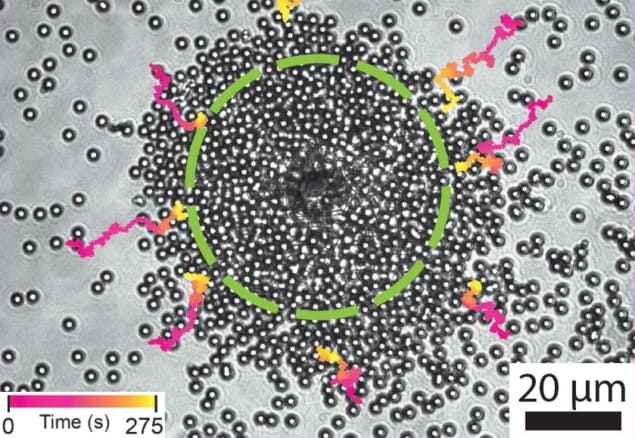
Physicists in the UK have designed a self-assembling photonic system, which can actively adapt the laser beams it produces in response to changing illumination. The team, led by Riccardo Sapienza at Imperial College London and Giorgio Volpe at University College London, based their design around a system of suspended microparticles, which formed dense clusters when the mixture was illuminated.
Many systems in nature can harness the energy in their surrounding environments to form coordinated structures and patterns within groups of individual elements. These range from schools of fish, which dynamically change their shape to evade predators, to the folding of proteins in response to bodily functions, such as muscle contraction.
An extensive field of research is now dedicated to emulating this self-organization in artificial materials, which can adapt and reconfigure themselves in response to their changing surroundings. In this latest research, reported in Nature Physics, Sapienza and Volpe’s team aimed to reproduce the effect in a laser device, which changes the light it produces as its environment is altered.
To achieve this, the researchers exploited a unique class of materials named colloids, in which particles are dispersed throughout a liquid. Since these particles can be easily synthesized with sizes comparable to the wavelengths of visible light, colloids are already widely used as the building blocks of advanced photonic devices – including lasers.
When their particles are suspended in solutions of laser dyes, these mixtures can scatter and amplify the light trapped within them, producing laser beams through optical pumping with another high-energy laser. So far, however, these designs have largely involved static colloids, whose particles can’t reconfigure themselves as their surroundings change.
In their experiment, Sapienza, Volpe and colleagues introduced a more advanced colloid mixture, in which titanium dioxide (TiO2) particles were evenly suspended in an ethanol solution of laser dye also containing Janus particles (which have two distinct sides with different physical properties). One half of the spherical surfaces of the Janus particles was left bare, while the other was coated with a thin layer of carbon, altering its thermal properties.
This meant that when the Janus particles were illuminated with a 632.8 nm HeNe laser, they generated a molecular-scale temperature gradient in the liquid surrounding them. This caused the TiO2 particles in the colloid to cluster themselves around the hot Janus particle and form an optical cavity. Once the illumination ended, the Janus particle cools and the particles disperse back to their original, uniform arrangements.

New semiconductor laser delivers high power at a single frequency
This unique behaviour allowed Sapienza and Volpe’s team to carefully control the sizes and densities of their TiO2clusters. Through optical pumping, they showed that sufficiently dense clusters could produce an intense laser, spanning a narrow range of visible wavelengths. The process was also completely reversible, with the laser dimming and broadening once illumination was removed.
In demonstrating a laser system that can actively respond to changes in illumination, the researchers hope their results could inspire a new generation of self-assembling photonic materials: suitable for applications as wide-ranging as sensing, light-based computing and smart displays.
